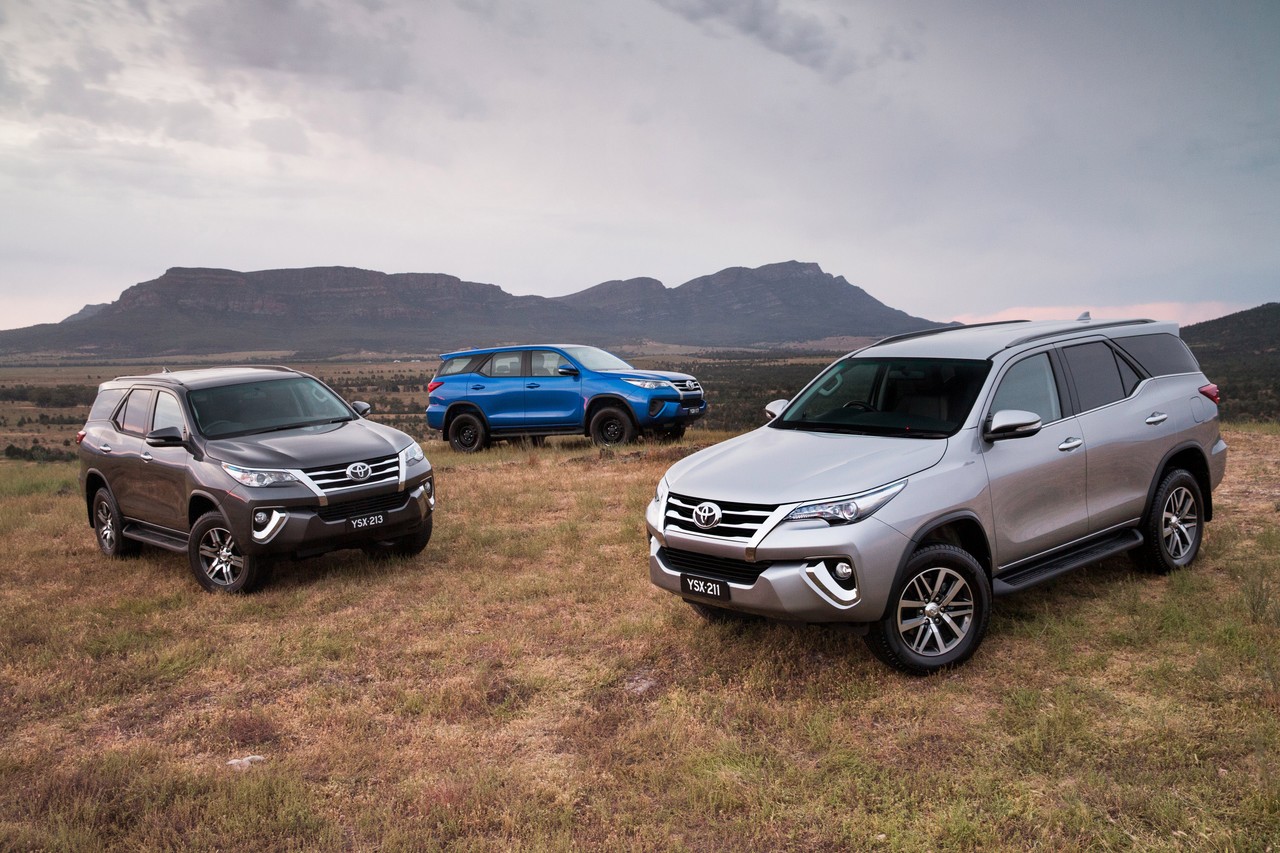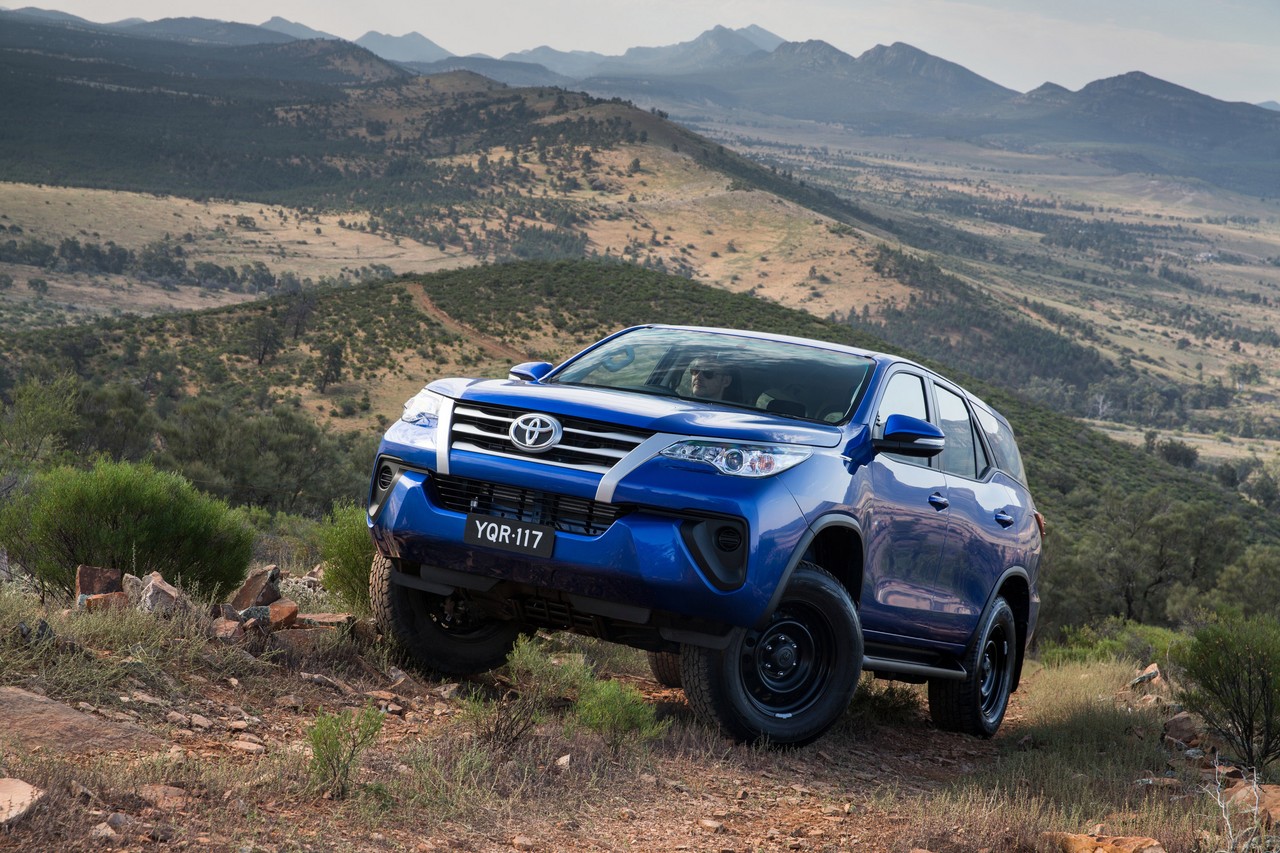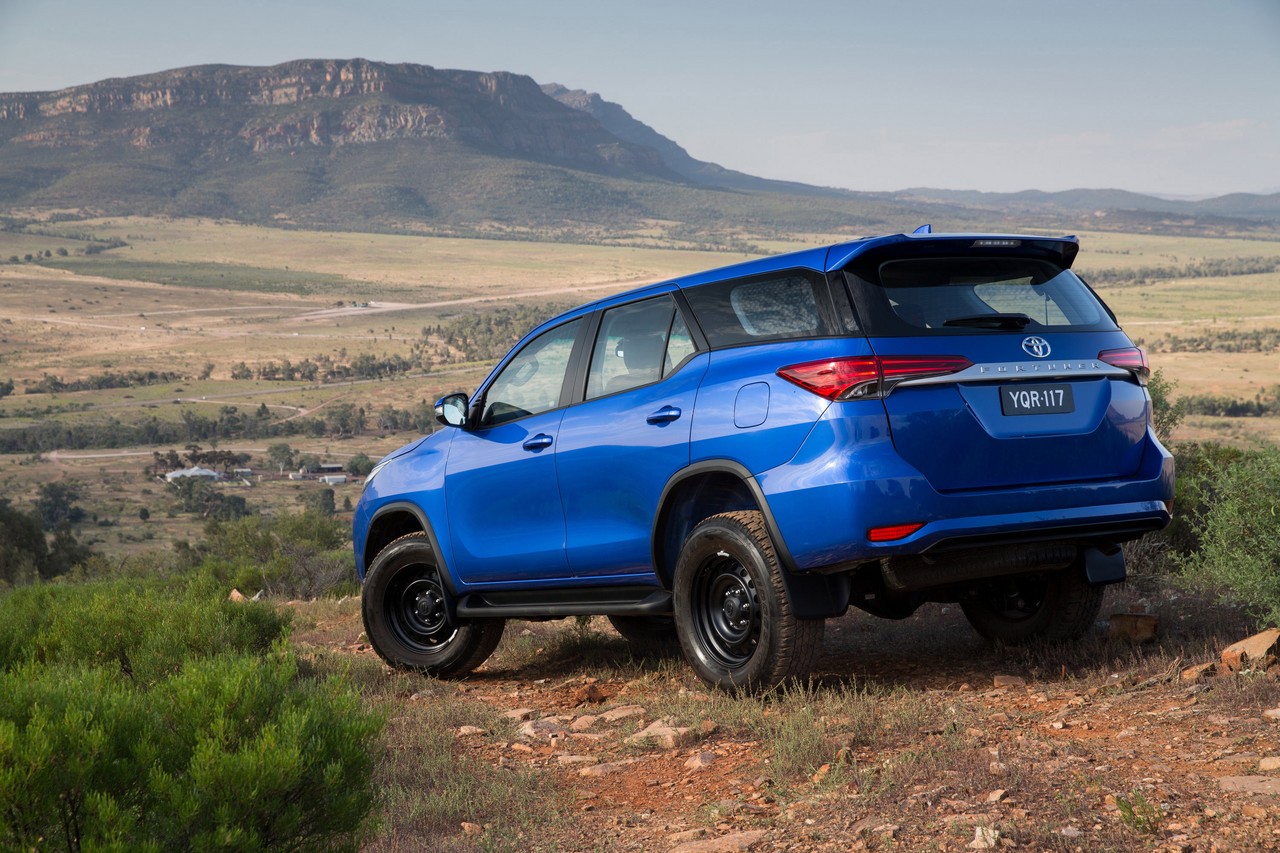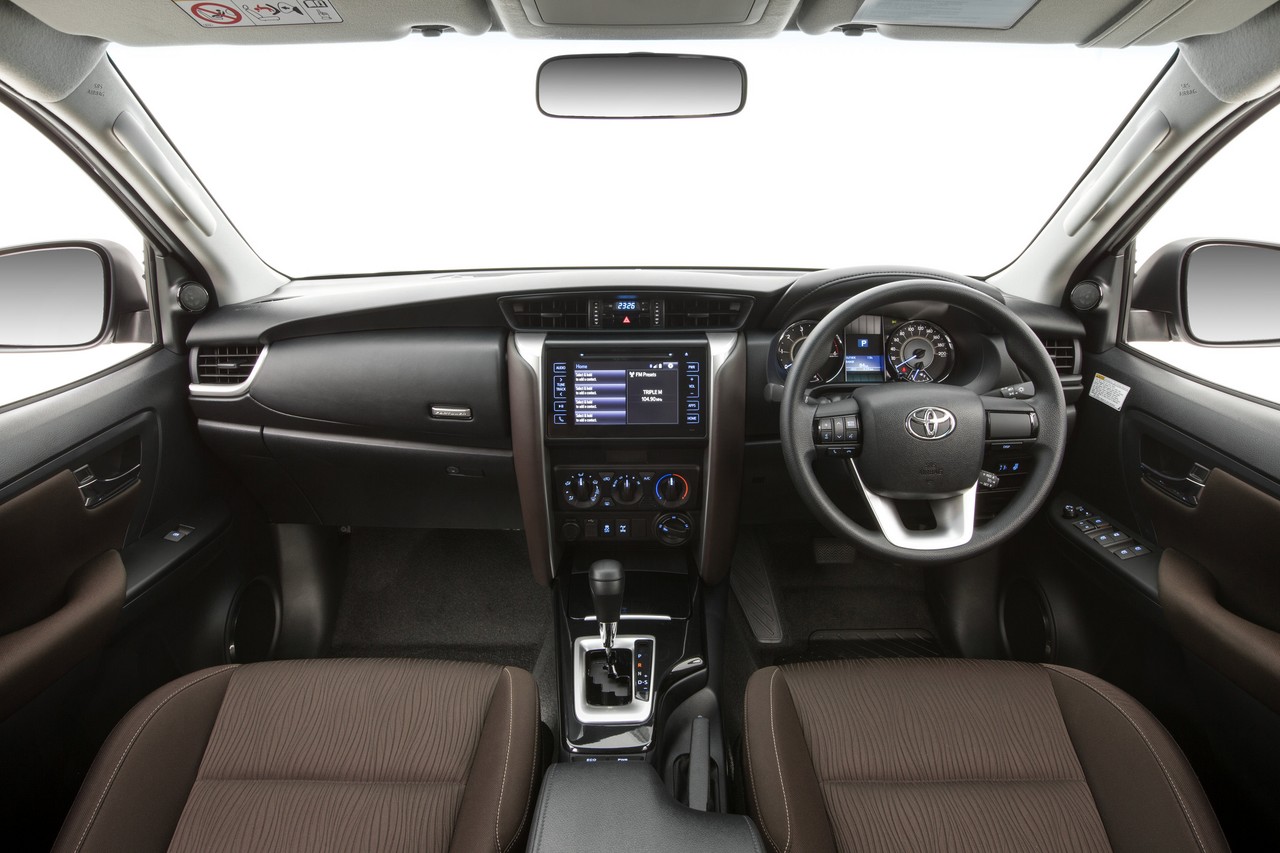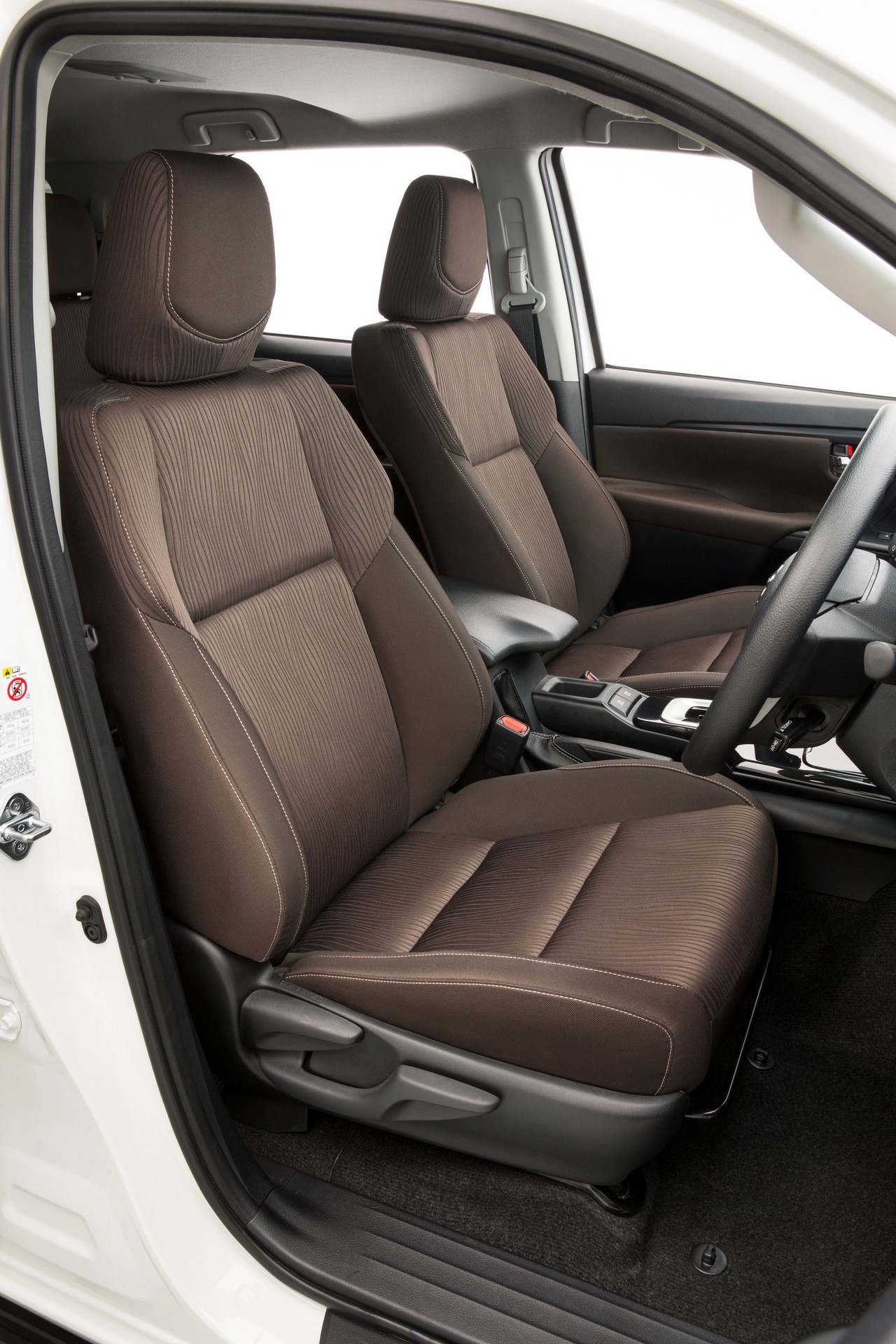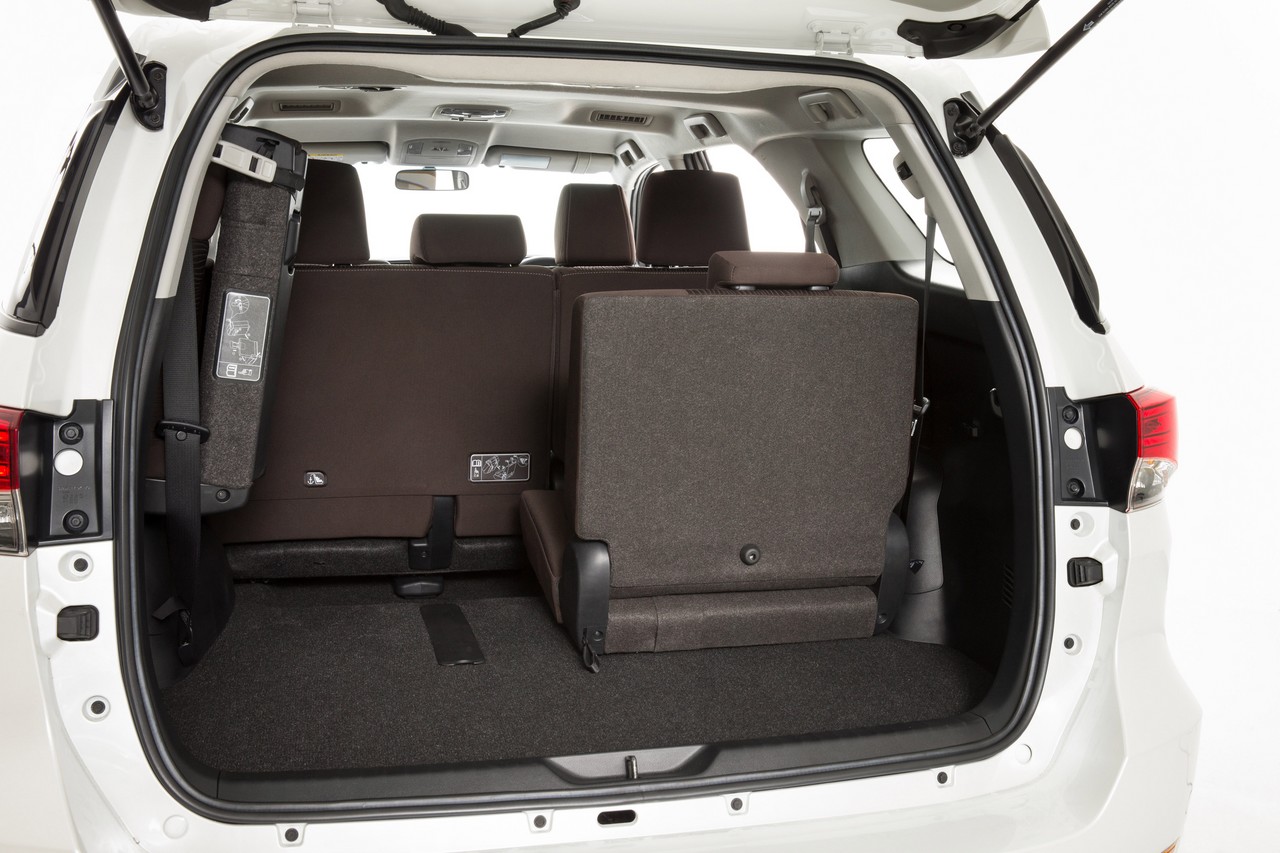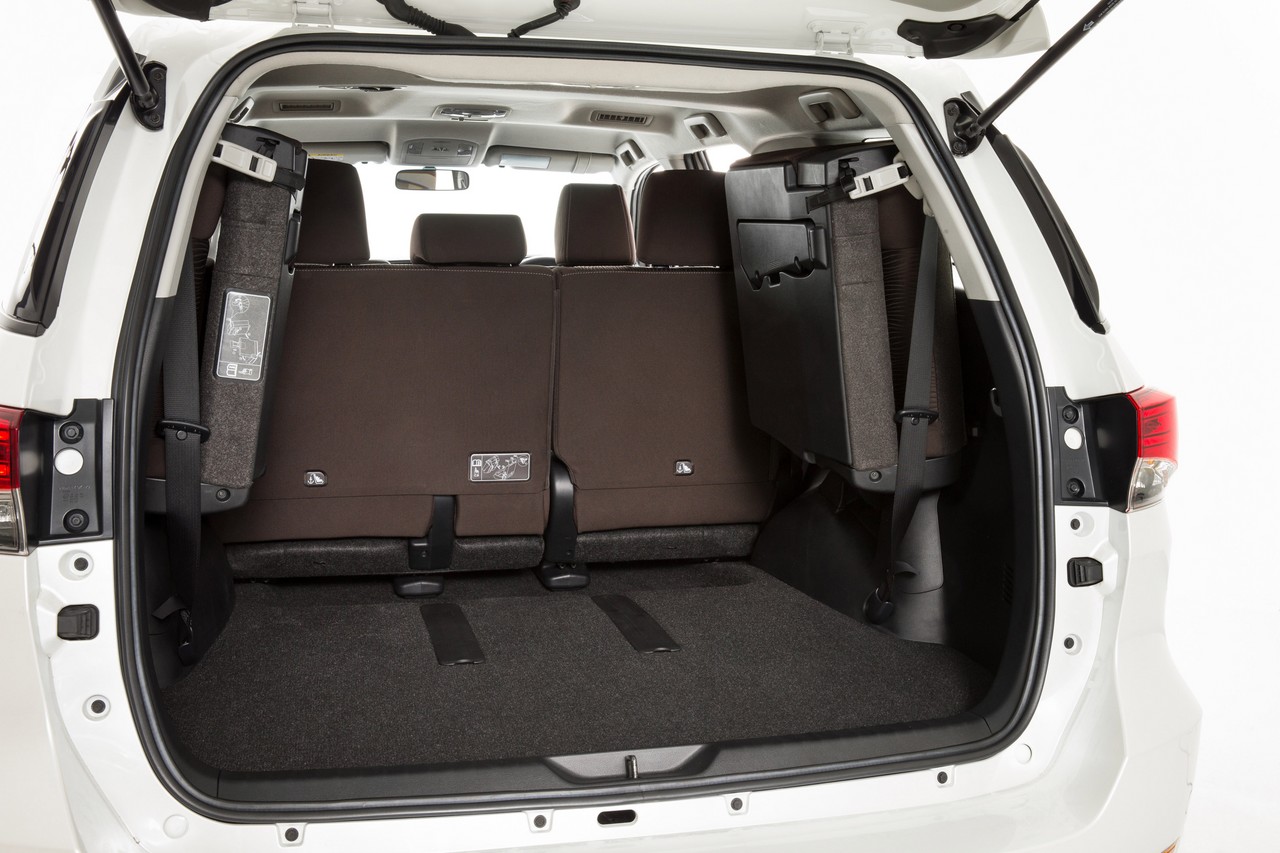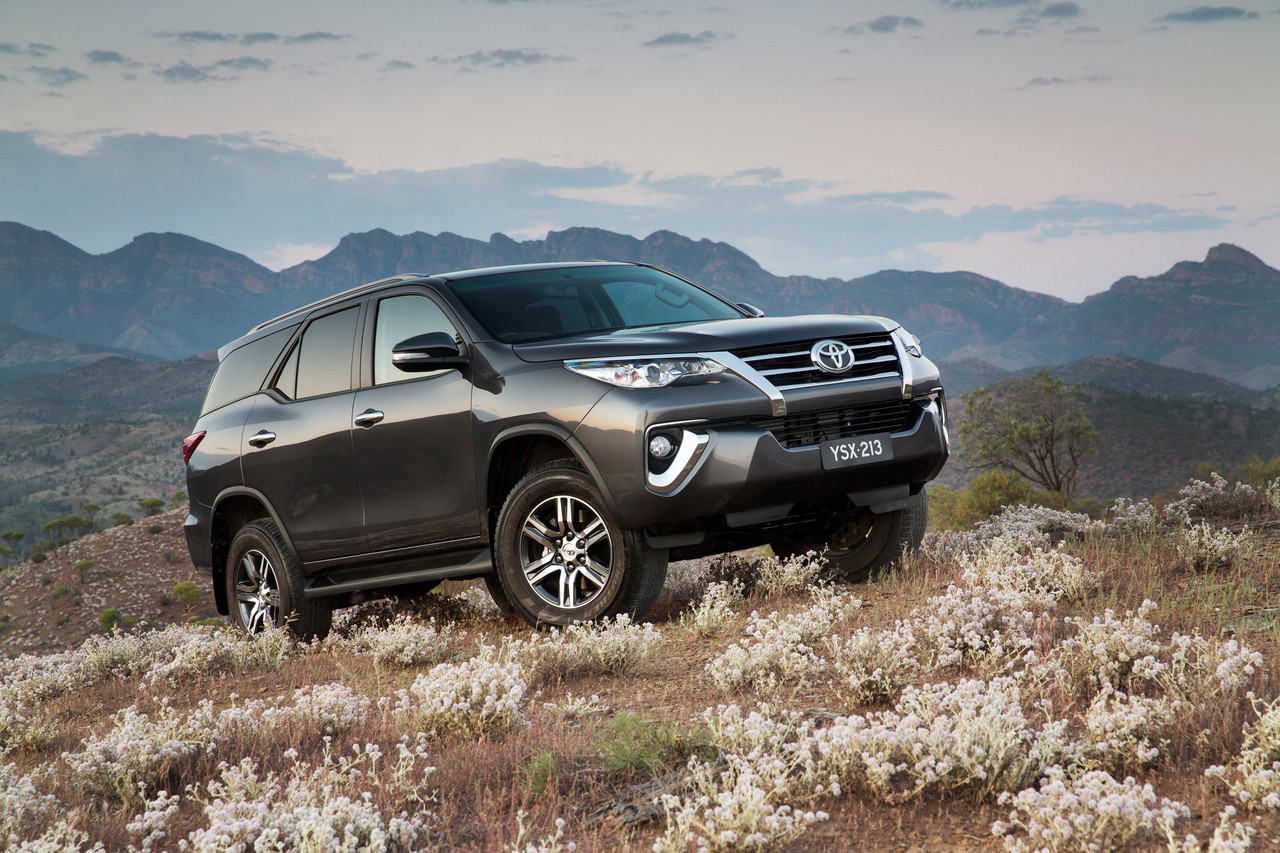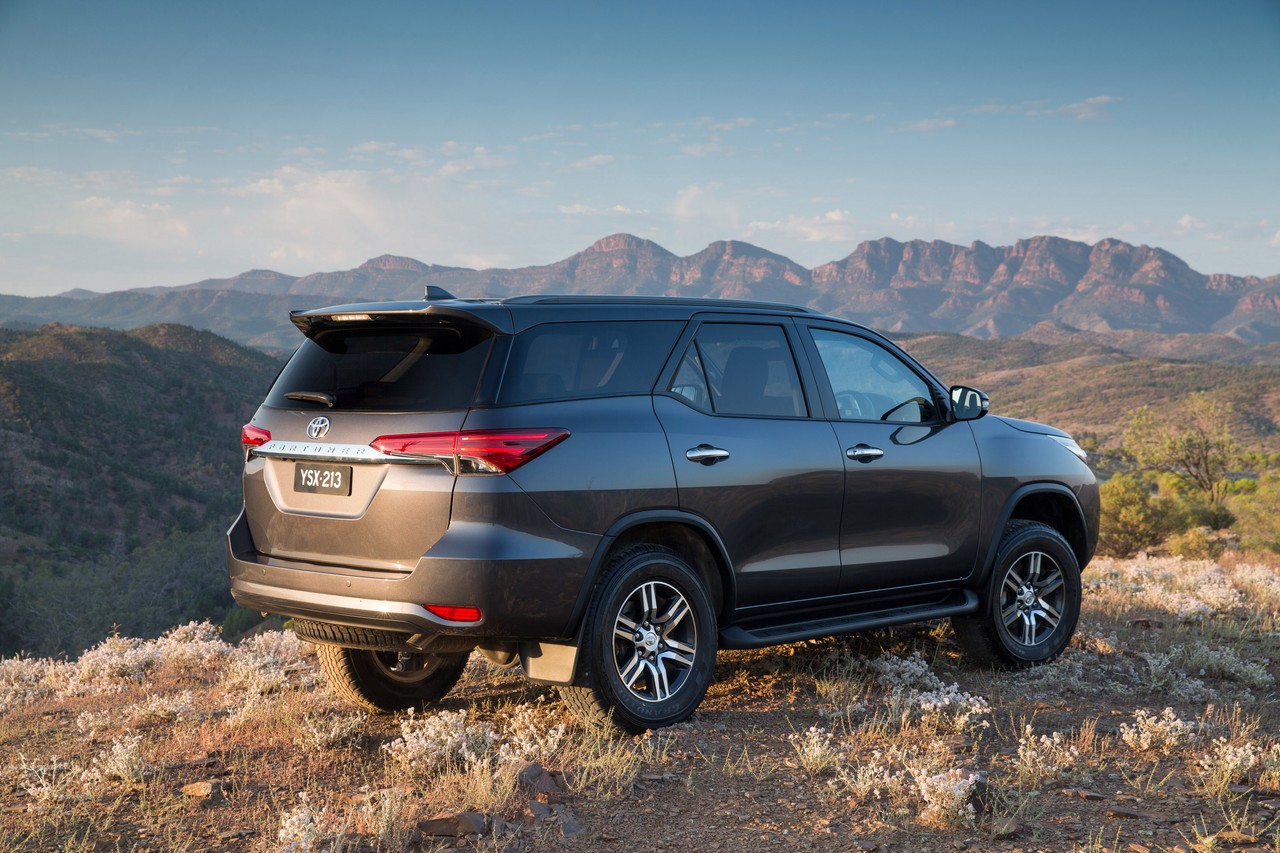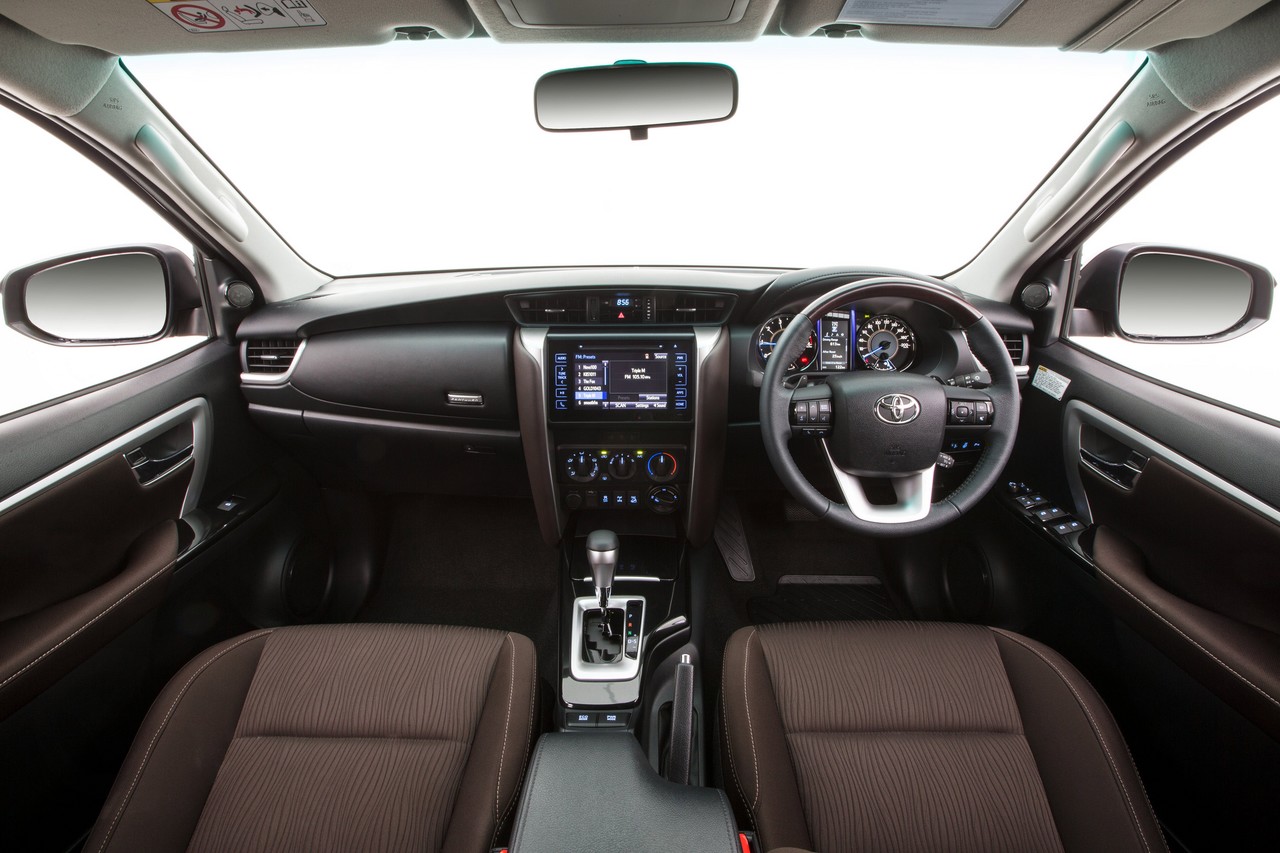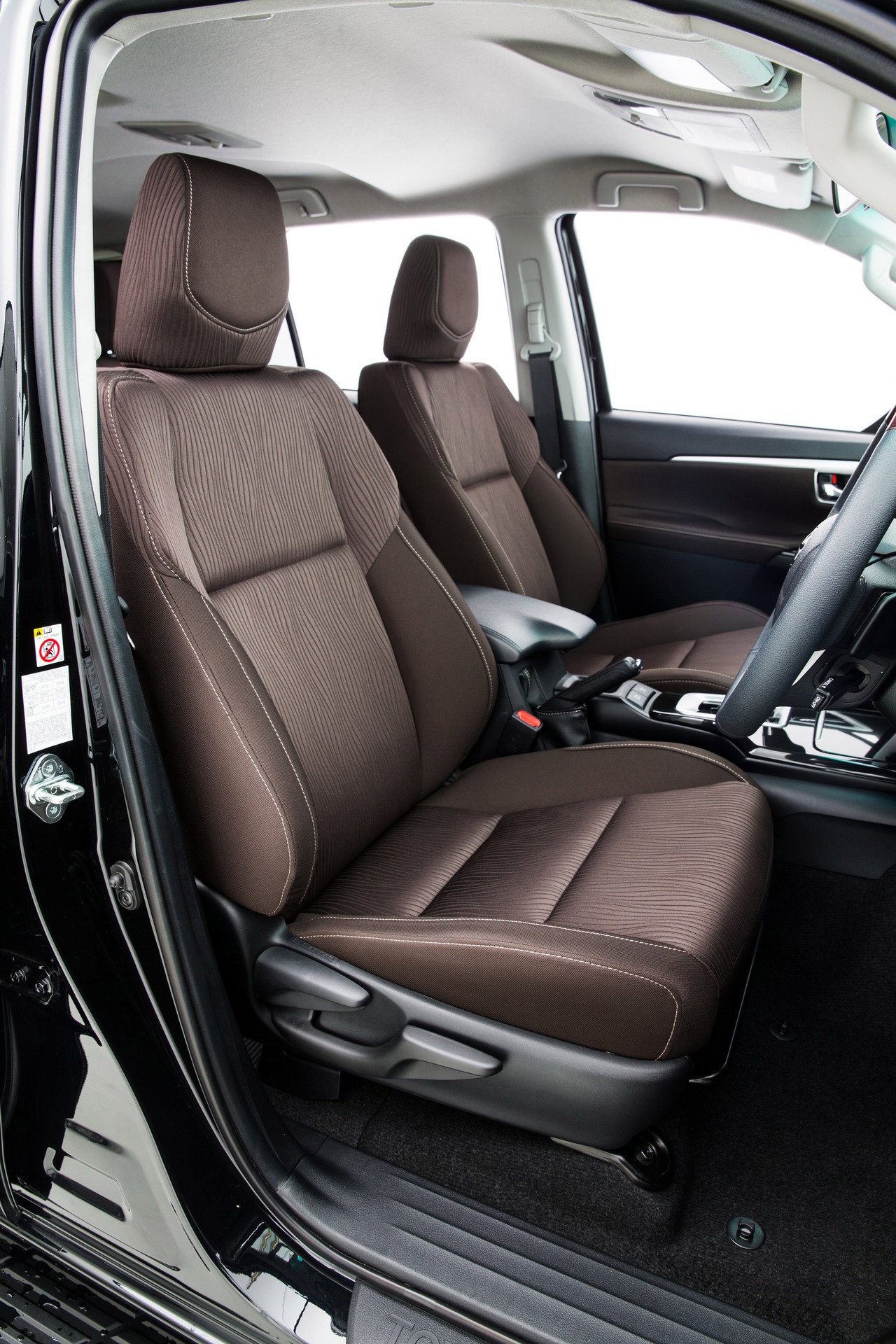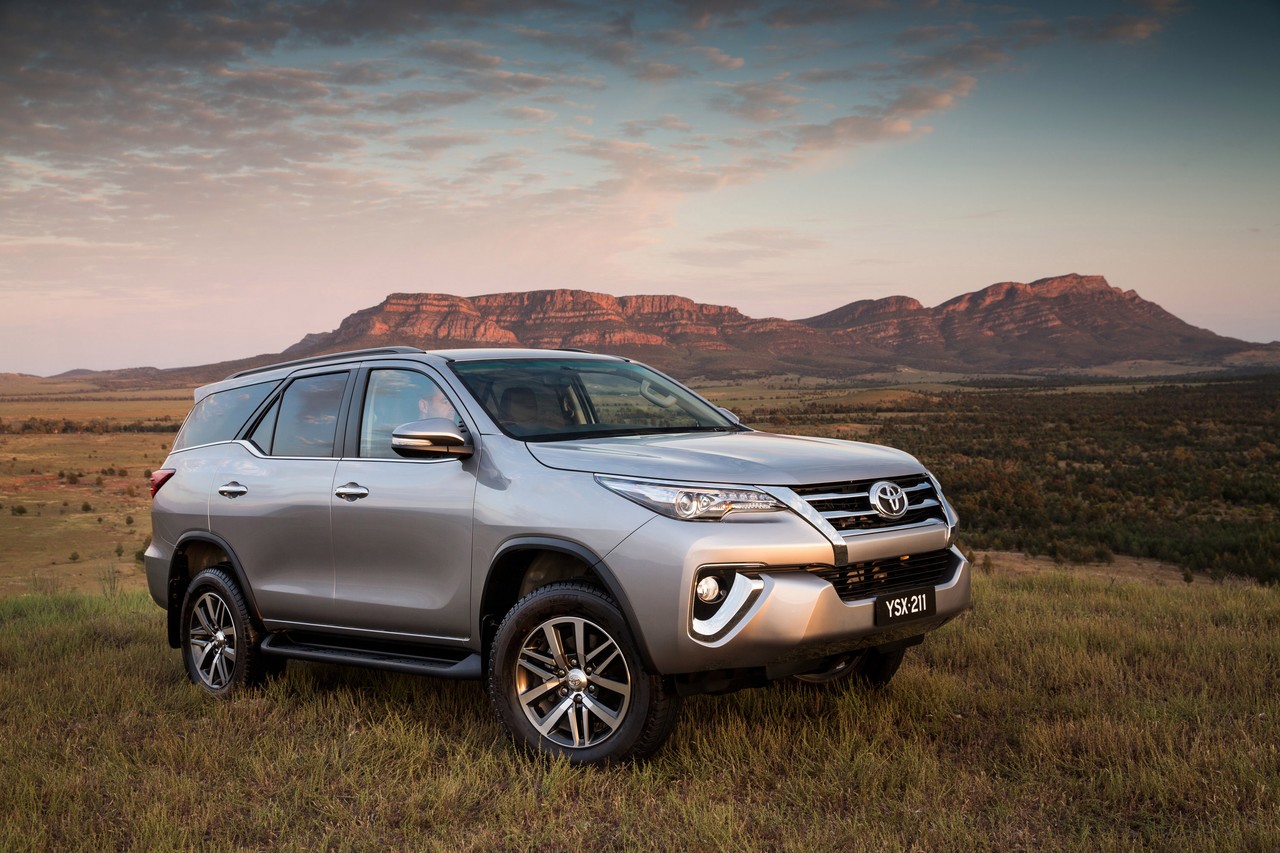
- Part-time 4WD system provides off-road ability
- Quiet 2.8-litre turbo-diesel engine when cruising
- Towing ability: 2800 kg and 3000 kg for auto and manual, respectively
- Steering lacks precision and feedback
- Suspension lacks compliance
- Narrow cabin
Overview
Released in Australia in October 2015, the Toyota AN160 Fortuner was a seven-seat SUV with a part-time four-wheel drive system. Manufactured in Samut Prakan, Thailand, the AN160 Fortuner was powered by Toyota’s 2.8-litre 1GD-FTV turbo-diesel engine which was mated to either a six-speed manual or six-speed automatic transmission. As per the table below, the Toyota Fortuner range consisted of GX, GXL and Crusade variants.
| Variant | Engine | Trans. | Peak power | Peak torque |
|---|---|---|---|---|
| GX, GXL, Crusade |
2.8-litre turbo-diesel I4 | 6sp man. | 130 kW at 3400 rpm | 420 Nm at 1400-2600 rpm |
| 6sp auto | 130 kW at 3400 rpm | 450 Nm at 1600-2400 rpm |
1GD-FTV engine
Toyota’s 1GD-FTV four-cylinder diesel engine had 92.0 mm bores and a 90.0 mm stroke for a capacity of 2755 cc, common-rail injection, a variable geometry turbocharger manufactured by Toyota, intake manifold with swirl control valve, double overhead camshafts (chain-driven), four valves per cylinder actuated by roller rockers, compression ratio of 15.6:1, water-cooled exhaust gas recirculation (EGR), a diesel particulate filter and counterbalance shaft. The diesel fuel injectors for the 1GD-FTV engine produced fuel droplets into two separate intake ports per cylinder: a tangential port for high swirl flow and a helical port for high volume.
Over the combined ADR 81/02 test cycle, fuel consumption for the Toyota Fortuner was 7.8 and 8.6 litres per 100 km for manual and automatic models, respectively. Braked towing capacity for the Toyota Fortuner was 2800 kg for models with automatic transmissions and 3000 kg for models with manual transmissions.
Transmissions
For the Toyota Fortuner, the six-speed AC60 automatic transmission had the following shift strategies –
- Deceleration Downshift Control: timed downshifts to suppress a decline in engine speed to improve fuel economy;
- Accelerator Immediate Close Control: maintained the current gear when the accelerator pedal was suddenly released to enhance engine braking;
- Accelerator Immediate Open Control: immediately downshifted when the accelerator pedal was suddenly depressed; and,
- High-speed Gear Effective Utilisation Control: determined the availability of high-speed gears according to current driving conditions.
For the Fortuner GXL and Crusade, the automatic transmission could be controlled via steering wheel gearshift paddles. Furthermore, the AC60 automatic transmission had an aluminium multi-plate transmission-fluid cooler built into the engine-coolant radiator.
For the six-speed RC61 manual transmission, the Fortuner GXL and Crusade variants were equipped with Toyota’s ‘intelligent manual transmission’ (iMT) function which matched engine revolutions to transmission revolutions for more refined gear shifts.
Body and dimensions
The Toyota AN160 Fortuner shared its front structure with the Toyota Mk.8 Hilux utility and had a body-on-frame chassis. The AN160 Fortuner body included 590 MPa high-tensile steel and, for high torsional rigidity, reinforced cross members and side rails. To resist rust, the body also utilised galvanised steel and anti-corrosive wax.
Relative to the Toyota 150-Series LandCruiser Prado , the Fortuner was 135 mm shorter (at 4795 mm), 30 mm narrower (1855 mm), 55 mm lower (1835 mm, including roof rails) and had a 45 mm shorter wheelbase (2745 mm). Kerb weight for the Toyota Fortuner ranged from 2110 kg to 2135 kg.
Inside, the Toyota Fortuner had a 2-3-2 seating configuration which included 60/40 split-fold second-row seats with a one-touch slide function and 50/50 split-fold third-row seats. The second row seats could be tilted and tumbled forward individually, while the third row seats could be stowed against the interior C-pillar. Furthermore, both the second and third row seats could be reclined. Cargo capacity for the Toyota Fortuner was 200 litres, though this increased to 1080 litres when the second and third row seats were re-positioned.
Suspension and steering
The Toyota AN160 Fortuner had double wishbone front suspension and a five-link rear axle with coil springs. To suppress body roll, the Fortuner has stabiliser bars front and rear.
The Toyota Fortuner had rack-and-pinion steering with hydraulic, speed-sensitive power-assistance; its turning circle was 11.6 metres.
4WD system and off-roading
The Toyota AN160 Fortuner had a part-time four-wheel drive system with an electronically-controlled transfer case. The transfer case provided high- and low-range gearing, with the driver able to activate various drive modes for the four-wheel drive system via an interior dial.
As standard, the Toyota Fortuner was fitted with a rear differential lock that was integrated in the differential housing. Off-roading specifications for the Toyota Fortuner included:
- 225 mm ground clearance;
- 700 mm wading depth;
- A 30 degree approach angle;
- A 25 degree departure angle; and,
- A 23.5 degree ramp-over angle.
The Toyota Fortuner GXL and Crusade were also fitted with downhill assist control which could maintain a constant speed when descending a hill, enabling the driver to concentrate on steering the vehicle.
Safety equipment
Standard safety equipment for the Toyota AN160 Fortuner included dual front airbags, a driver’s knee airbag, front seat-mounted side airbags, full-length curtain airbags, ABS, electronic brake force distribution, brake assist, electronic stability control (including trailer sway control), traction control and front seatbelts with pre-tensioners and load limiters.
From October 2019 deliveries, the AN160 Fortuner was equipped with the following ‘Toyota Safety Sense’ technologies –
- Pre-Collision Safety System (PCS) with day/night vehicle and pedestrian detection and daytime cyclist detection: operating at speeds above 10 km/h, PCCS used a front-mounted monocular camera sensor and millimetre-wave radar sensor to detect vehicles and pedestrians on the road ahead, during the day or at night; cyclists could also be detected during daylight. If there was a collision risk, the driver would receive an audible warning and a ‘Brake’ message would be shown on the multi-information display. In its second stage, Pre-Collision Brake Assist prepared the braking system so that it would respond faster if the brake pedal was depressed. If the driver did not react and a collision was imminent, maximum braking force would be applied automatically to reduce the severity of the collision;
- High-Speed Active Cruise Control (ACC): operating at speeds above 40 km/h, High-Speed ACC could maintain a safe distance from the vehicle ahead by braking and accelerating up to the maximum cruising speed set by the driver;
- Lane Departure Alert (LDA) with steering assistance: used the windscreen-mounted camera to monitor the vehicle’s position relative to lane markings on the road surface. If the vehicle was about to depart from its lane without the turn indicator having been applied, an audible tone would alert the driver and a warning would appears in the multi-information display. If the Fortuner continued to move outside the lane, the brakes would be applied to wheels on one side of the vehicle to oppose the lane departure; and,
- Road Sign Assist (RSA): the windscreen-mounted camera could recognise certain speed limit signs so that the speed limit was displayed on the multi-information display (MID) in the instrument cluster. Furthermore, when RSA detected a speed-limit sign that was different to the pre-set cruise-control speed, the driver could use steering-wheel switches to reset the vehicle speed to match the new speed limit.
ANCAP crash testing
In ANCAP crash tests , the Toyota Fortuner received a five star adult occupant protection rating with a score of 33.95 out of 37. In the frontal offset test, protection of the driver’s chest, thighs and feet were rated as good, though head and lower left leg protection were rated as adequate (i.e. a slight risk of serious injury) and lower right leg protection was marginal. In the side impact test, however, maximum points were awarded.
Brakes
The Toyota Fortuner had 338 mm ventilated front brake discs with opposed-piston callipers and 312 mm ventilated rear discs with floating callipers.
Features: Toyota Fortuner GX
Standard features for the Toyota Fortuner GX included 17-inch steel wheels with 265/65 R17 all-terrain tyres, a six speaker sound system with a CD player and auxiliary inputs (USB/3.5 mm), ‘Toyota Link’ connectivity system with a seven-inch display and voice recognition, Bluetooth mobile phone connectivity and audio streaming, air conditioning, brown fabric seat coverings, a six-way adjustable driver’s seat and a four-way adjustable front passenger seat, cruise control, projector-style headlamps, automatic headlights, remote central locking, power windows and mirrors, tilt and telescopic steering column adjustment, three 12 volt power sockets, an air-conditioned cool box, a trip computer, an alarm and immobiliser.
Features: Toyota Fortuner GXL
Relative to the GX, the Fortuner GXL was further equipped with 17-inch alloy wheels, front fog lamps, rear parking sensors, a premium steering wheel and gearshift knob, proximity key (i.e. keyless entry), push-button start, roof rails, privacy glass, roof rails and a 4.2-inch colour display for the trip computer. Furthermore, Fortuner GXL and Crusade variants with automatic transmissions were also fitted with steering wheel gearshift paddles.
The Fortuner GXL could be identified by its chrome exterior handles, grille and tailgate garnish.
Features: Toyota Fortuner Crusade
The range-topping Fortuner Crusade was distinguished by its 18-inch alloy wheels with 265/60 R18 highway tyres, digital radio tuner (DAB+), satellite navigation system with seven-inch touchscreen, climate control air conditioning, leather upholstery (in fawn or dark brown colours), an eight-way power adjustable driver’s seat, bi-LED headlights, LED daytime running lamps, a power-operated tailgate, 220 volt/100 watt accessory socket, ‘woodgrain look’ interior trim and a soft-touch console box lid.
October 2017 update
In October 2017, Toyota reduced retail prices for each variant within the AN160 Fortuner range by at least $5000 and standard features were also extended –
- The Fortuner GX gained 17-inch alloy wheels (previously steel wheels) and rear parking sensors;
- The Fortuner GXL gained satellite navigation with a seven-inch touchscreen and digital radio tuner (DAB+); and,
- The Fortuner Crusade gained an eleven speaker JBL audio system, an eight-way power adjustable front passenger seat and heated front seats. Furthermore, the halogen fog lamps were replaced with LED units.
August 2018 update: DPF switch
From August 2018, the Toyota Fortuner was fitted with a ‘Diesel Particulate Filter’ switch which could be used to manually initiate regeneration of the diesel particulate filter (DPF) after a warning signal was issued to the driver. Specifically, regeneration injected extra diesel fuel post-combustion to raise exhaust gas temperatures so that particulate matter on the filter would be burnt off. While DPF regeneration was normally initiated by the engine control unit (ECU), regeneration would only initiate if the vehicle were driven at high speeds for long periods.
October 2019 update
In addition to the changes to safety equipment, the Toyota Fortuner GX was fitted with a 4.2-inch colour display in the instrument cluster from October 2019 deliveries – this had previously been reserved for the Fortuner GXL and Crusade variants.
Brochure
Related links
- Toyota Australia: Early Christmas for Toyota Fortuner Buyers (October 2017)
- Toyota Australia: Toyota Fortuner Press Kit (October 2015)
- Toyota Australia: 2015 Toyota Fortuner Reveal Press Kit (July 2015)
- Toyota Australia: World Premiere For Seven-Seat Toyota Fortuna (July 2015)
